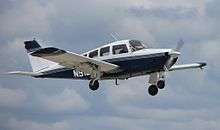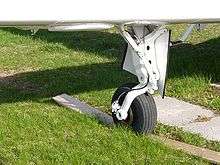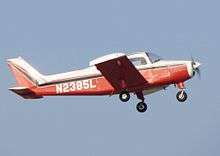Beechcraft Musketeer
| Musketeer | |
|---|---|
 | |
| Beechcraft A23 Musketeer | |
| Role | Light personal and trainer aircraft |
| Manufacturer | Beech Aircraft Corporation |
| Produced | 1963-1983 |
| Number built | 4,366 |
| Variants | CT-134 Musketeer |
The Beechcraft Musketeer is a family of single-engined, low-wing, light aircraft that was produced by Beechcraft. The line includes the Model 19 Musketeer Sport, the Model 23 Musketeer, Custom and Sundowner, the Model 23-24 Musketeer Super III the retractable gear Model 24-R Sierra and the military CT-134 Musketeer.
The Musketeer line was in production from model years 1963 to 1983, during which time a total of 4,366 were produced.[1] The type certificate for the Musketeer family of aircraft has been owned by Hawker Beechcraft since 26 March 2007.[2]
Development
Model 23 Musketeer and Custom
The first of the line was the Model 23. It was introduced under the "Musketeer" name as a 1963 model at an initial price of $13,300 and was powered by a Lycoming O-320-D2B engine of 160 bhp (120 kW). The next year this engine was replaced by the Continental IO-346-A engine of 165 bhp (123 kW). This engine was not a success and was in turn replaced by the Lycoming O-360-A4J engine of 180 bhp (130 kW) starting with the B23 Musketeer Custom of 1968. In 1970 the C23 version was introduced also under the name "Musketeer Custom". In 1972 the C23 was renamed the "Sundowner". When properly equipped, the B23 and C23 are approved for limited aerobatics.[1]
A total of 2,331 Beechcraft 23s of all variants were manufactured by the time production was completed 20 years later in 1983.[1]
Model 19 Musketeer Sport

The Beech 19 was introduced as a 1966 model year. Despite having a lower model number, it was a later variant and was a lower-powered trainer version of the Model 23. It lacked the 23’s third side window and had a Lycoming O-320-E2C powerplant of 150 bhp (110 kW). The Sport was introduced in 1966 with a standard price of $11,500. When properly equipped, the A19, B19, and M19 Sports are approved for limited aerobatics.[1]
The Model 19 was named the "Musketeer Sport" and a total of 922 were built over the 15 years of production which ended with the 1979 model year.[1]
Model 23-24 Musketeer Super III
Along with the introduction of the lower-powered Model 19 in 1966, Beechcraft also introduced a higher-powered version of the Model 23 Musketeer and named it the Beechcraft 23-24 Musketeer Super III. This upgraded model had a Lycoming IO-360 fuel injected powerplant which produced 200 bhp (150 kW), 35 hp (26 kW) more than the standard Model 23 Musketeer of that year. This model initially sold for a price of $16,350 in 1966.
In 1966 a single demonstration Model 23-24 was equipped with a constant speed propeller. In succeeding years approximately one third of production aircraft were delivered with the constant speed propeller.
The Super Musketeer typically has a useful load of 1050 to 1080 pounds – giving it one of the highest payloads of four-cylinder, fixed gear, simple single-engined aircraft available. Most Model 23-24s were produced in a four-seat configuration. A very small number were produced with a 4+2 configuration with the baggage area convertible to seat two children. This configuration option was more common on the Sierra models that followed the Model 23-24.
One of the few weaknesses of the Model 23-24 was that it had a simple heat distribution system that provided warm air via the firewall to the area under the instrument panel only. This meant heat to the rear seat passengers was less than optimal. Later aircraft featured increasingly better ducting designs that provided heat to all four seating positions.
The fixed-gear Model 23-24 was produced only between 1966 and 1969. A total of 369 Musketeer Super IIIs were completed before it was superseded by the Model 24 Sierra. These were serial numbered MA-1 to MA-369 and were the only models to have a "MA" serial number, making them easier to distinguish than other members of the Musketeer line. In the last few airframes of the series a new instrument panel with the same "vertical tape" gauges that were used in the early Sierras was introduced. These models were known as the A24 and are not to be confused with the first Sierras, which were designated A24R models. Other than the instrument panel these aircraft were mechanically identical to the earlier A23-24 model.[1]
Model 24 Sierra


The Model 23-24 Musketeer Super III proved the utility of the 200 hp (150 kW) engine in the Musketeer airframe, but the fixed-gear configuration prevented using full advantage of the extra power of the injected Lycoming. The obvious solution was retracting the landing gear and this resulted in the Model 24R.
The Musketeer Super R, A24R in 1970 was the first model year for the new retractable version of the Musketeer to compete with the Piper Arrow.
Renamed the "Sierra", in 1972. The initial A24-R Sierra was powered by a Lycoming IO-360-A1B of 200 bhp (150 kW) and sold for a standard price of $24,950. The Model 24R completed the Beech line between the fixed gear Musketeers and the much larger, faster, more complex and expensive Beechcraft Bonanza.
1974 saw the introduction of the improved B24-R Sierra powered by the Lycoming IO-360-A1B6 engine and new propeller variant as a 1974 model year. The improved C24-R in 1977 was powered by the same engine and larger propeller. Beech also did an aerodynamic cleanup on the "C" model making it 6 knots faster than the "B" model it replaced in 1977 .
Sierra production ended at the same time as the Model 23 Sundowner assembly line was closed up, during the aviation economic downturn of 1983. A total of 744 Sierras were delivered.[1]
The Musketeer design was further developed into a twin-engined aircraft, the Beechcraft Model 76 Duchess.
CT-134 Musketeer
The Canadian Forces purchased twenty-four 1971 model B23 Musketeers, with the first CT-134 arriving at CFB Portage la Prairie on March 23, 1971. The initial batch of CT-134s was replaced in late 1981 with twenty-four 1982 model Beechcraft C23 Sundowners, which were designated by the CF as CT-134A Musketeer II.[3][4]
Design
Landing gear
The main difference between the Musketeer line and other similar light aircraft is the Musketeer’s landing gear. While the competitive Cessna 172s use spring-steel main gear, the Piper PA-28 Cherokees use oleos and the Grumman American AA-5s use fiberglass-sprung main gear, the Musketeer family use a trailing idler link gear system with a compressed rubber puck suspension system. This gives the aircraft quite different landing characteristics compared to the competition; light touchdowns are often accompanied by the idler links skipping and producing a less-graceful than anticipated landing. With practice, smooth landings are easy to accomplish.
As a result of this type of landing gear design, Beechcraft did not design or offer wheel fairings for the fixed gear models. Several aftermarket manufacturers have designed and tested wheel fairings for Musketeers.[5]
Operational history
During their production years the Musketeer family of aircraft were popular trainers and were used by many flying schools. Most Musketeers are now privately owned.
Variants

- 23 Musketeer
- Four-seat light cabin aircraft, fixed tricycle landing gear, powered by a 160 hp (119 kW) Lycoming O-320-D2B piston engine, gross weight of 2,300 lb (1,043 kg), first certified 20 February 1962.[2]
- A23 Musketeer II
- Four-seat light cabin aircraft, fixed tricycle landing gear, powered by a 165 hp (123 kW) Continental IO-346-A piston engine, gross weight of 2,350 lb (1,066 kg), first certified 7 June 1963.[2]
- A23A
- Four-seat light cabin aircraft, fixed tricycle landing gear, powered by a 165 hp (123 kW) Continental IO-346-A piston engine, gross weight of 2,400 lb (1,089 kg), first certified 5 November 1965.[2]
_at_the_2013_Australian_International_Airshow.jpg)
- A23-19 (Model 19)
- Two or four-seat light cabin aircraft, fixed tricycle landing gear, powered by a 150 hp (112 kW) Lycoming O-320-E2B, E2C or E3D piston engine, gross weight of 2,200 lb (998 kg), first certified 9 December 1965.[2]
- A23-24
- Four or six-seat light cabin aircraft, fixed tricycle landing gear, powered by a 200 hp (149 kW) Lycoming IO-360-A2B or A2D, or when equipped with a constant speed propeller a Lycoming IO-360-A1B or A1D piston engine, gross weight of 2,550 lb (1,157 kg), first certified 7 March 1966.[2]
- A24
- Four or six-seat light cabin aircraft, fixed tricycle landing gear, powered by a 200 hp (149 kW) Lycoming IO-360-A2B or A2D, or when equipped with a constant speed propeller a Lycoming IO-360-A1B or A1D piston engine, gross weight of 2,550 lb (1,157 kg), first certified 5 February 1970.[2]
- 19A
- Two or four-seat light cabin aircraft, fixed tricycle landing gear, powered by a 150 hp (112 kW) Lycoming O-320-E2B, E2C or E3D piston engine, gross weight of 2,250 lb (1,021 kg), first certified 31 August 1967, approved in the aerobatic category 12 March 1968.[2]
- M19A
- Two-seat light cabin aircraft, fixed tricycle landing gear, powered by a 150 hp (112 kW) Lycoming O-320-E2B, E2C or E3D piston engine, gross weight of 2,250 lb (1,021 kg), first certified 9 December 1969, including in the aerobatic category.[2]
- B19
- Two or four-seat light cabin aircraft, fixed tricycle landing gear, powered by a 150 hp (112 kW) Lycoming O-320-E2B, E2C or E3D piston engine, gross weight of 2,250 lb (1,021 kg), first certified 13 February 1970, including in the aerobatic category.[2]
- B23
- Four-seat light cabin aircraft, fixed tricycle landing gear, powered by a 180 hp (134 kW) Lycoming O-360-A2G piston engine, gross weight of 2,450 lb (1,111 kg), first certified 13 December 1967 and in the aerobatic category 22 November 1968.[2]
- C23
- Four-seat light cabin aircraft, fixed tricycle landing gear, powered by a 180 hp (134 kW) Lycoming O-360-A4G, A2G, A4J or A4K piston engine, gross weight of 2,450 lb (1,111 kg), first certified 13 February 1970 including in the aerobatic category.[2]
- A24R Sierra 200
- Four or six-seat light cabin aircraft, retractable tricycle landing gear, powered by a 200 hp (149 kW) Lycoming IO-360-A1B or A1D piston engine, gross weight of 2,750 lb (1,247 kg), first certified 23 December 1969.[2]
- B24R Sierra 200
- Four or six-seat light cabin aircraft, retractable tricycle landing gear, powered by a 200 hp (149 kW) Lycoming IO-360-A1B6 piston engine and new propeller variant, gross weight of 2,750 lb (1,247 kg), first certified 18 June 1973 sold as a 1974 model also had a new larger rear baggage door.[2]
- C24R Sierra 200
- Four or six-seat light cabin aircraft, retractable tricycle landing gear, powered by a 200 hp (149 kW) Lycoming IO-360-A1B6 piston engine, gross weight of 2,750 lb (1,247 kg), first certified 1 October 1976 with a new larger prop and aerodynamic cleanup by Beech made it 6 knots faster than the "B" .[2]
Operators
Military operators
- Algerian Air Force (4 x B24R Sierra)
- Canadian Armed Forces (24 x B23 and 24 x C23 Sundowners, designated as CT-134)
- Royal Hong Kong Auxiliary Air Force (2 x B23-19)
- Mexican Air Force (20 x A23-19)
- Royal Moroccan Air Force (1 x 23)
Specifications
A23A Musketeer Custom III
Data from Airliners.net[6] The Incomplete Guide to Airfoil Usage[7]
General characteristics
- Crew: one
- Capacity: three passengers
- Length: 25 ft 8 in (7.82 m)
- Wingspan: 32 ft 9 in (9.98 m)
- Height: 8 ft 3 in (2.51 m)
- Wing area: 146 sq ft (13.6 m2)
- Airfoil: NACA 63A415
- Empty weight: 1,375 lb (624 kg)
- Gross weight: 2,400 lb (1,089 kg)
- Powerplant: 1 × Continental IO-346-A four cylinder air-cooled horizontally opposed aircraft piston engine, 165 hp (123 kW)
- Propellers: 2-bladed fixed pitch
Performance
- Maximum speed: 127 kn (146 mph; 235 km/h)
- Cruise speed: 102 kn (117 mph; 189 km/h) long range cruise speed
- Stall speed: 63 kn (72 mph; 117 km/h)
- Never exceed speed: 152 kn (175 mph; 282 km/h)
- Range: 676 nmi (778 mi; 1,252 km) with reserves
- Service ceiling: 13,000 ft (4,000 m)
- Rate of climb: 728 ft/min (3.70 m/s)
See also
- Related development
- Aircraft of comparable role, configuration and era
References
- 1 2 3 4 5 6 7 Aircraft Bluebook Spring 2006 Edition Penton Media, Overland Park, KS USA
- 1 2 3 4 5 6 7 8 9 10 11 12 13 14 15 Federal Aviation Administration (March 2006). "TYPE CERTIFICATE DATA SHEET A1CE Revision 35" (PDF). Retrieved 30 March 2010.
- ↑ Air Force Public Affairs / Department of National Defence (2004-04-06). "Beech CT-134 Musketeer". Retrieved 2007-09-17.
- ↑ Milberry, Larry: Sixty Years – The RCAF and Air Command 1924-1984, page 384. McGraw Hill Ryerson Canav Books, 1984. ISBN 0-07-549484-1
- ↑ Rellihan (October 2007). "Wheel Pants For the 19/23/23-24!". Retrieved 2011-04-13.
- ↑ Demand Media (2010). "The Beech 19/23/24 Musketeer/Sierra/Sport/Sundowner". Retrieved 2010-02-06.
- ↑ Lednicer, David (October 2007). "The Incomplete Guide to Airfoil Usage". Archived from the original on 15 May 2008. Retrieved 2008-06-28.
External links
| Wikimedia Commons has media related to Beechcraft Musketeer. |
- Airliners.net Musketeer page